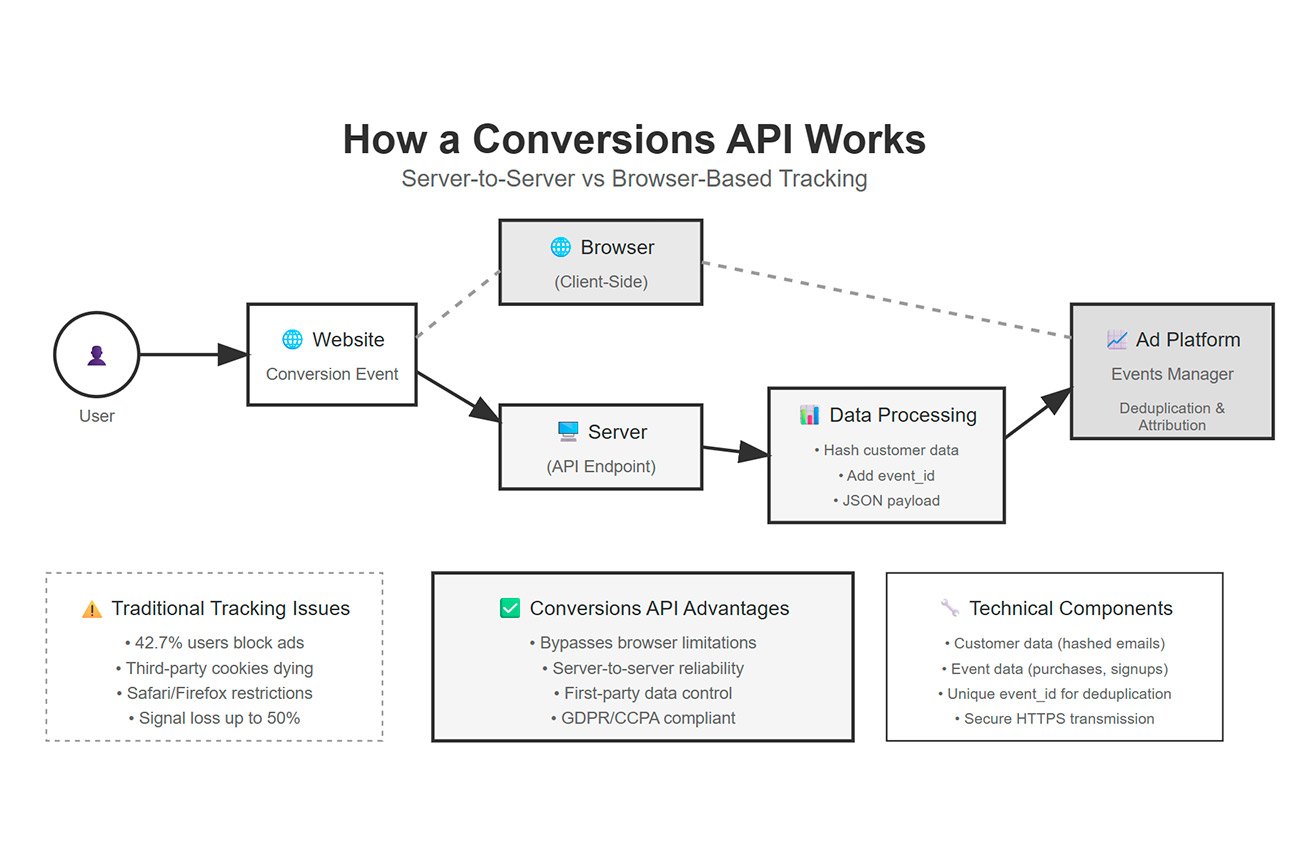
What Is a Conversions API?
Digital tracking is in crisis: 42.7% of global internet users actively block ads, undermining the reliability of Facebook Pixel and other client-side tracking tools. Add to that the looming end of third-party cookies—blocked by Safari and Firefox and set to be phased out in Chrome by 2025—and marketers face serious data accuracy gaps.
Enter the conversions API—a server-to-server pipeline that sends conversion data directly to ad platforms, bypassing the user’s browser and capturing conversion events with higher precision. Businesses using Facebook conversions API have seen up to 19% more attributed purchases than those using Pixel alone.
In this article, we’ll explore what a conversion API is, how conversions API work, and why combining it with AI-powered website personalization transforms conversion tracking from a passive measurement tool into a predictive, optimization-driven engine.
Quick Takeaways
- Over 42.7% of internet users worldwide use ad blockers, leading to significant data loss in client-side tracking.
- The conversion api sends conversion data directly from your server to ad platforms, bypassing ad blockers and boosting data accuracy.
- Unlike client-side tracking using Facebook Pixel, conversion APIs are a server‑to‑server solution, offering greater control over conversion events and customer data.
- Major advertising platforms like Facebook, Google, and Twitter support this method, seeing better campaign performance and campaign performance insights.
- Businesses using Meta’s Conversions API have reported up to 19% more attributed purchases compared to relying on Pixel alone (Meta Business Help Center).
- The conversions API bypasses third-party cookies limitations, a critical issue since Safari and Firefox now block them by default, and Chrome will phase them out by 2025.
- Combining Facebook Pixel and CAPI ensures conversion tracking redundancy and deduplication for a complete picture of the customer journey.
What is a Conversions API?
A conversion api is a server‑side tracking tool that transmits conversion events directly from your server—such as purchases, form submissions, or downloads—to platforms like Facebook, Google, or LinkedIn, bypassing browser events entirely.
How Conversions API Works
When a user interacts with your website, both the Pixel (via browser) and the conversion API (via server) can send a conversion event. Your backend dispatches a JSON payload of event details—timestamp, hashed user data, event type—over HTTPS to the ad platform’s endpoint. Proper setup includes deduplication via unique event_id to avoid double-counting.

Key Components
- Customer data (hashed emails, phone numbers)
- Event data (purchases, signups)
- Secure data transfer and compliance tools for GDPR/CCPA
- Support for both online and offline events, including offline conversions and in‑store purchases.
Why Businesses Need Conversion APIs
Overcoming Tracking Blockers
With more than half of browser-side conversions going untracked due to privacy settings or ad blockers, relying solely on Pixel means missing key parts of the customer journey. Conversion APIs counteract this by collecting data directly from the server.
Accurate Data in Analytics
By merging both browser-tracked and server-tracked data, you dramatically improve data accuracy and reduce signal loss.
Privacy and Compliance
Conversions APIs allow you to control exactly what customer data you send, aligning with data privacy regulations such as GDPR and CCPA. This builds both legal compliance and user trust.
Full-Funnel Attribution, Including Offline Sales
Unlike traditional tracking, which often stops at the click, the conversion api supports offline events like in-store purchases and phone orders. This means you can link offline conversions back to online campaigns, improving campaign performance across channels.
Optimization with Richer Event Signals
By sending detailed event data—such as order values, product categories, and crm data—via server-side tracking, ad platforms can optimize campaigns more effectively. This helps optimize ad spend and refine ad targeting for high-value audiences.
Benefits of Using Conversion API
Enhanced Campaign Performance
With more reliable conversion tracking, ad platforms can optimize for the right behaviors—delivering stronger results and better ROI.
Improved Audience Targeting and Personalization
Server-side tracking supports granular behavioral data capture, such as loyalty tier conversions or mid-funnel interactions—fueling smarter segmentation and AI-driven personalization.
Privacy Resilience
Without relying on third-party cookies, conversion APIs remain functional even as browsers and regulators restrict tracking—ensuring long-term performance stability.
How Major Platforms Use Conversion APIs
Facebook Conversions API
Meta’s API works in tandem with the Facebook Pixel in Events Manager. You can send both browser and server events, with deduplication via event_id. This approach offers full-funnel visibility—even for offline events.
Google, Twitter, Pinterest
Google’s “Enhanced Conversions” and other platforms deploy similar events api models that securely ingest website events server-side and enhance ad targeting.

Conversions API vs Traditional Tracking
Client-Side vs Server-Side
- Client-side tracking tools like the Facebook pixel collect web events directly in the user’s browser. While easy to set up, they are vulnerable to ad blockers, cookie restrictions, and the limitations of the user’s browser.
- Server-side tracking with the conversion api processes conversion events on your own server before sending them securely to advertising platforms. This avoids signal loss from browser-based limitations and third-party cookie deprecation.
Accuracy and Control
With traditional tracking, a large percentage of website events may never reach your ad platforms due to privacy settings or connectivity issues. The conversions api ensures more accurate data by allowing you to send event data directly, merge it with crm data, and deduplicate it alongside browser events. This improves conversion tracking match rates and campaign optimization.
Data Privacy and Compliance
Traditional tracking sends raw data from the browser, which can raise compliance risks if not properly anonymized. In contrast, server-side tools like the conversions api allow you to hash customer data before sending, ensuring safer data transfer and better compliance with data privacy regulations such as GDPR and CCPA.
Flexibility for Advanced Marketing Technology
Because API integration is controlled on the backend, you can enrich conversion data with additional context—like offline conversions, product details, or lifetime value—before sending it. This level of customization is rarely possible with traditional tracking setups.
![]()
What Data Can Conversion API Collect?
Types of Events
- Web events: clicks, page views
- App events
- Offline conversions: in-store or offline sales
- Purchases, content downloads, form submissions
- Custom events tied to specific actions—e.g., premium subscription signups
Sources of Customer Data
- CRM data, such as emails and phone numbers
- First-party website data collected with consent
- Party data that you explicitly decide to share
Setting Up a Conversion API
Basic Technical Requirements
- API access to the ad platform (e.g., developer account on Meta/Google)
- Backend access to send HTTP POST requests
- Technical knowledge for integration or the use of third-party tools
Direct Integration vs Tools
- Many advertising platforms offer built-in wizards or direct integration options for the Facebook conversions api—for example, Shopify has a native setup that requires no coding.
- If you’re a Shopify merchant, you can follow our detailed step-by-step tutorial here: How to Set Up Facebook Conversions API on Shopify to complete your integration efficiently.
- Pure DIY implementations require technical resources and api linking, while partner tools simplify the process for teams without development expertise.
Secure Transmission
Always send customer data via secure HTTPS channels and comply with hashing requirements before transfer. This protects user privacy while ensuring data accuracy in your conversion tracking setup.
Best Practices for Implementing Conversion API
- Combine Pixel and Conversion API for full coverage and deduplication
- Regularly test using the platform’s events manager
- Align event names with business KPIs
- Send rich signals (email, phone, value) to improve match quality
- Use AI personalization to turn signals into tailored customer experiences
- Continuously monitor campaign performance and output accuracy
Real-World Use Cases
- E‑commerce: Track “add to cart”, purchases, and custom funnels beyond browser tracking
- EduTech: Tie form submissions or course enrollment to precise paid-channel conversions
- FinTech and Banking: Accurately monitor sign-ups and conversions while maintaining privacy
The Future: Conversion API + AI Personalization
Tracking is only half the battle—melding conversion API data with machine learning–powered personalization allows real-time inference and content adaptation without A/B testing. That’s what makes AI services like FunnelFlex’s AI Personalization and AI Prediction truly transformative.
Conclusion
Conversion APIs are swiftly becoming the backbone of modern attribution and optimization frameworks. By sending conversion events directly from your server—without reliance on cookies—you achieve far more accurate data, resilience to privacy shifts, and full control over the customer data you share. Unlike browser-based tools like the Facebook pixel, conversion APIs ensure your campaign performance and conversion tracking remain effective, even as Firefox, Safari, and iOS tighten limitations.
Leading advertising platforms from Facebook to Google and Twitter now embrace that model. When combined with Pixel, conversion APIs deliver redundancy, deduplication, and end-to-end visibility—from ad click to offline purchase. That kind of visibility is critical for optimizing ad spend, fueling better marketing strategies, and reducing inefficiencies.
The real magic unfolds when you layer in AI personalization and AI Prediction. Imagine delivering dynamically tailored customer experiences informed by accurate event signals—without manual A/B testing. FunnelFlex’s solutions offer precisely that: ML-powered personalization engineered to maximize conversions, build complete customer profiles, and drive ROI across EduTech, FinTech, Banking, and beyond.
Ready to turn secure conversion tracking into performance-driving personalization? Let’s make your data work smarter—without extra dev work.
FAQs
What is the difference between the conversions API and Meta Pixel?
Conversion API is server-side, offering more accurate data and bypassing browser blockers, while Meta Pixel depends on the user’s browser and is prone to signal loss.
Is the conversion API worth it?
Absolutely—especially if you care about accuracy, performance, and privacy compliance. It’s a key tool for maintaining visibility in a cookieless, ad-blocked world.
What are the 4 types of API?
Broadly speaking: Web APIs, Library APIs, Operating System APIs, and Hardware APIs—though in marketing, we’re focused on the “conversion API” which is a server-to-server analytics interface.
Is the Facebook conversion API free?
Yes—the Facebook conversion API itself is free to use, though setup may require resources or platform fees based on your system or tools.
Is the conversion API GDPR compliant?
It can be—because you control what customer data you send. As long as data is hashed, sent securely, and consented to, conversion APIs support GDPR compliance.
